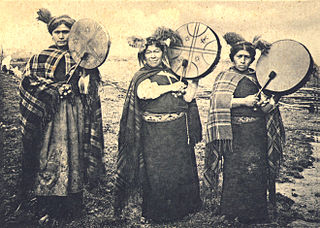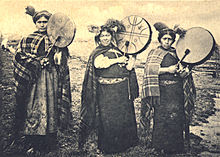Animism is the belief that objects, places, and creatures all possess a distinct spiritual essence. Animism perceives all things—animals, plants, rocks, rivers, weather systems, human handiwork, and in some cases words—as being animated, having agency and free will. Animism is used in anthropology of religion as a term for the belief system of many Indigenous peoples in contrast to the relatively more recent development of organized religions. Animism is a metaphysical belief which focuses on the supernatural universe : specifically, on the concept of the immaterial soul.

The Indigenous peoples of the Americas comprise numerous different cultures. Each has its own mythologies, many of which share certain themes across cultural boundaries. In North American mythologies, common themes include a close relation to nature and animals as well as belief in a Great Spirit that is conceived of in various ways.
Gualichu, or gualicho, in Mapuche mythology and mainly in the Tehuelche culture, was an evil spirit or demon, comparable but not similar to the Devil.

The Mapuche is a group of native indigenous inhabitants of south-central Chile and southwestern Argentina, including parts of Patagonia. The collective term refers to a wide-ranging ethnicity composed of various groups who share a common social, religious, and economic structure, as well as a common linguistic heritage as Mapudungun speakers. Their homelands once extended from Choapa Valley to the Chiloé Archipelago and later spread eastward to Puelmapu, a land comprising part of the Argentine pampa and Patagonia. Today the collective group makes up over 80% of the indigenous peoples in Chile and about 9% of the total Chilean population. The Mapuche are concentrated in the Araucanía region. Many have migrated from rural areas to the cities of Santiago and Buenos Aires for economic opportunities.
The Nguruvilu is a creature originating from the Mapuche religion of the indigenous people inhabiting Chile. It is a river-dwelling creature that looks like a fox, with a long body, similar to a snake, and a long tail with fingernails that it uses like a claw.
Kalku or Calcu, in Mapuche mythology, is a sorcerer or witch who works with black magic and negative powers or forces. The essentially benevolent shamans are more often referred to as machi, to avoid confusion with the malevolent kalku. Its origins are in Mapuche tradition.

A machi is a traditional healer and religious leader in the Mapuche culture of Chile and Argentina. Machis play significant roles in Mapuche religion. In contemporary Mapuche culture, women are more commonly machis than men, but it is not a rule. Male machi are known as Machi Weye.
The Chilote mythology or Chilota mythology is formed by the myths, legends and beliefs of the people who live in the Chiloé Archipelago, in the south of Chile. This mythology reflects the importance of the sea in the life of Chilotes.
The legend of Trentren Vilu and Caicai Vilu (Kaikai) is a Mapuche flood myth that tells the story of a fierce battle between two mythical snakes, Trentren Vilu and Caicai Vilu. It explains how the Chilóe archipelago and mountains of southern Chile came to have its unique geography.
Ten Ten-Vilu or Trentren-Vilu is the Mapuche god of earth and fertility ; he has a generous spirit and is the protector of all life on Earth, and the flora and fauna and according to some Mapuche myths. This snake was a central figure in the origin of the Chiloean Archipelago. In Mapuche mythology, Ten Ten-Vilu is son of Antü.

Coi Coi-Vilu or Caicai-Vilu/Cai Cai Vilu is the Mapuche god of water and, according to Mapuche myths, supreme ruler of the sea and of all sea-dwellers. This snake was a central figure in the origin of the Chiloean Archipelago. In Mapuche mythology, Coi Coi-Vilu is son of Peripillan.
Chilean mythology includes the mythology, beliefs and folklore of the Chilean people.
The Pillan are powerful and respected male spirits in Mapuche mythology.
In Mapuche mythology, Ngen or " Ngen-ko " are spirits of nature of the Mapuche beliefs. In Mapudungun, the word ngen means "owner".
The wekufe, also known as huecufe, wekufü, watuku, huecufu, huecubo, huecubu, huecuvu, huecuve, huecovoe, giiecubu, güecubo, güecugu, uecuvu, güecufu; is an important type of harmful spirit or demon in Mapuche mythology. The word wekufe comes from the Mapudungun word wekufü meaning "demon, outside being".

A rehue or kemukemu is a type of pillar-like sacred altar used by the Mapuche of Chile and Argentina in many of their ceremonies.
Antu is the name given to the principal Pillan spirit in Mapuche mythology. Antü is the most powerful Pillán, who governs the other Pillans. In Mapuche mythology, Antu represents the Sun, as well as light, wisdom and spirit, and is opposite to darkness and the physical world, and is married to Kueyen, a Wangulén spirit that represents the moon.
Kueyen or kuyen is the name given to the moon in Mapuche mythology. She is the principal wangulen spirit. Kueyen governs the others wangulen spirits. Kueyen is married Antu.
Ngenechen is one of the most important Ngen spirits within traditional Mapuche religion; and is the most important deity in the present beliefs of the Mapuche people.
Ana Mariella Bacigalupo is a Peruvian anthropologist. She is a full professor at the State University of New York at Buffalo and has previously taught throughout the USA and in Chile. Her research primarily focuses on the shamans or machis of the Mapuche community of Chile, and the ways shamanic practices and beliefs are affected by and influence communal experiences of state power, mythical history, ethics, gender, justice, and identity.






